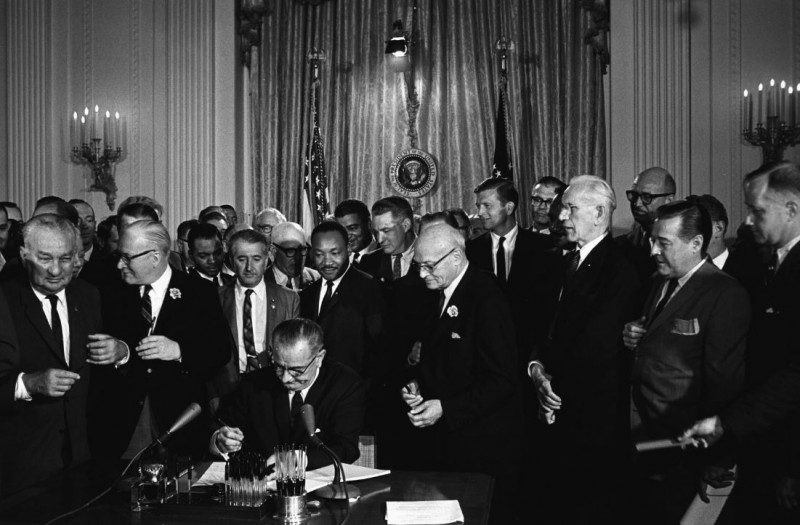
The Civil Rights Act of 1964 stands as a historic landmark in the ongoing fight against racial discrimination in the United States. This groundbreaking legislation, enacted by Congress and signed into law by President Lyndon B. Johnson, aimed to eradicate racial segregation and provide equal protection under the law for all citizens. By exploring its historical significance, key provisions, and impact, we can gain a deeper understanding of the Act's lasting legacy and its role in shaping a more inclusive society.
Introduction
The Civil Rights Act of 1964 marked a pivotal moment in American history, ushering in a new era of equality and justice. This comprehensive legislation sought to address the deeply ingrained racial discrimination that permeated various aspects of society. By outlawing segregation and discriminatory practices, the Act aimed to create a more inclusive and equitable nation for all.
Historical Context
To fully appreciate the significance of the Civil Rights Act, it is essential to understand the historical context in which it emerged. The 1960s witnessed a burgeoning civil rights movement, fueled by the tireless efforts of activists, leaders, and ordinary citizens who fought for racial equality. The Act was a response to the persistent racial injustices faced by African Americans, who endured systemic discrimination and disenfranchisement.
Key Provisions of the Civil Rights Act
The Civil Rights Act of 1964 encompassed a wide range of provisions that aimed to dismantle racial discrimination in various spheres of public life. Some of its key provisions included:
Title I: Voting Rights
Title I of the Act addressed voting rights and sought to remove barriers that prevented African Americans from exercising their right to vote. It prohibited literacy tests, poll taxes, and other discriminatory practices that hindered voter registration and participation.
Title II: Public Accommodations
Title II tackled racial segregation in public spaces, such as hotels, restaurants, theaters, and retail establishments. It made it illegal to deny individuals access to these facilities based on their race, color, religion, or national origin.
Title VI: Desegregation of Public Facilities
Title VI aimed to eliminate segregation in public facilities, including schools, parks, and public transportation. It mandated that any institution receiving federal funding must desegregate and provide equal opportunities to all individuals.
Title VII: Employment Discrimination
Title VII addressed racial discrimination in the workplace, making it illegal for employers to discriminate based on race, color, religion, sex, or national origin. It established the Equal Employment Opportunity Commission (EEOC) to investigate and address complaints of discrimination.
The Impact of the Civil Rights Act
The Civil Rights Act of 1964 had a profound impact on American society. It paved the way for significant advancements in civil rights and marked a turning point in the nation's history. Some of the key impacts of the Act include:
Desegregation: The Act played a crucial role in desegregating public spaces, leading to greater inclusivity and equal access for all individuals.
Voting Rights: By eliminating discriminatory practices, the Act expanded voting rights for African Americans and other marginalized communities, enhancing political representation and participation.
Employment Equality: Title VII's provisions led to increased workplace diversity and equal employment opportunities, challenging discriminatory practices and fostering a more inclusive labor market.
Social Transformation: The Act sparked a broader social transformation, inspiring subsequent civil rights legislation and galvanizing further activism and advocacy for marginalized communities.
Challenges and Ongoing Struggles
While the Civil Rights Act of 1964 represented a monumental achievement, challenges and ongoing struggles persist in the quest for racial equality. Discrimination, both overt and systemic, continues to impact marginalized communities in various aspects of life, including education, housing, and criminal justice.
Efforts to address these issues involve continued activism, legislative reforms, and societal changes that promote equity and justice. It is crucial to recognize that the Civil Rights Act was just the beginning of a long journey towards achieving true racial equality in the United States.
Conclusion
The Civil Rights Act of 1964 remains a seminal moment in American history, symbolizing the collective determination to combat racial discrimination and promote equality. Its impact continues to reverberate, shaping the nation's trajectory towards a more inclusive society. While challenges persist, the Act stands as a testament to the power of collective action and serves as a reminder of the work still to be done to ensure justice and equal rights for all.
ISRO to launch Chandrayaan-3 on Friday, Know All about the mission
Manipur Violence: Tribal Leader Forum Regrets Kuki Zo Conflict